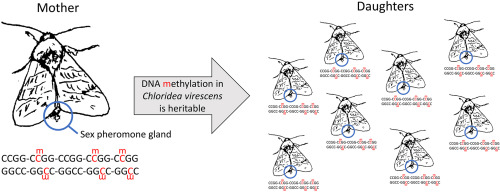当前位置:
X-MOL 学术
›
Insect Biochem. Mol. Biol.
›
论文详情
Our official English website, www.x-mol.net, welcomes your
feedback! (Note: you will need to create a separate account there.)
DNA methylation patterns in the tobacco budworm, Chloridea virescens.
Insect Biochemistry and Molecular Biology ( IF 3.2 ) Pub Date : 2020-04-04 , DOI: 10.1016/j.ibmb.2020.103370 Rik Lievers 1 , Peter Kuperus 1 , Astrid T Groot 2
Insect Biochemistry and Molecular Biology ( IF 3.2 ) Pub Date : 2020-04-04 , DOI: 10.1016/j.ibmb.2020.103370 Rik Lievers 1 , Peter Kuperus 1 , Astrid T Groot 2
Affiliation

|
DNA methylation is an important epigenetic modification that is prone to stochastic variation and is responsive to environmental factors. Yet changes in DNA methylation could persist across generations and thus play an important role in evolution. In this study, we used methylation-sensitive amplified fragment length polymorphisms (MS-AFLP) to evaluate whether DNA methylation could contribute to the evolution of the sexual communication signal in the noctuid moth Chloridea virescens. We found that most DNA methylation was consistent across tissues, although some methylation sites were specifically found in pheromone glands. We also found significant DNA methylation differences among families and two pheromone phenotype selection lines, and these differences correlated with genetic variation. Most DNA methylation patterns were inherited, although some sites were subject to spontaneous de novo DNA methylation across generations. Thus, DNA methylation likely plays a role in a wide range of processes in moths. Together, our results present an important initial step towards understanding the potential role of DNA methylation in the evolution of sexual communication signals in moths.
中文翻译:

烟草芽孢杆菌(Chloridea virescens)中的DNA甲基化模式。
DNA甲基化是重要的表观遗传修饰,容易发生随机变异,并且对环境因素敏感。然而,DNA甲基化的变化可能会持续几代人,因此在进化中起着重要作用。在这项研究中,我们使用了甲基化敏感的扩增片段长度多态性(MS-AFLP)来评估DNA甲基化是否可能有助于夜蛾蛾Chloridea virescens中性通讯信号的进化。我们发现大多数DNA甲基化在整个组织中是一致的,尽管在信息素腺体中特别发现了一些甲基化位点。我们还发现家庭和两个信息素表型选择系之间的显着DNA甲基化差异,这些差异与遗传变异相关。大多数DNA甲基化模式是遗传的,尽管有些站点几代人都经历了自发的从头DNA甲基化。因此,DNA甲基化可能在飞蛾的广泛过程中起作用。总之,我们的研究结果为理解DNA甲基化在飞蛾性通讯信号进化中的潜在作用提供了重要的第一步。
更新日期:2020-04-06
中文翻译:

烟草芽孢杆菌(Chloridea virescens)中的DNA甲基化模式。
DNA甲基化是重要的表观遗传修饰,容易发生随机变异,并且对环境因素敏感。然而,DNA甲基化的变化可能会持续几代人,因此在进化中起着重要作用。在这项研究中,我们使用了甲基化敏感的扩增片段长度多态性(MS-AFLP)来评估DNA甲基化是否可能有助于夜蛾蛾Chloridea virescens中性通讯信号的进化。我们发现大多数DNA甲基化在整个组织中是一致的,尽管在信息素腺体中特别发现了一些甲基化位点。我们还发现家庭和两个信息素表型选择系之间的显着DNA甲基化差异,这些差异与遗传变异相关。大多数DNA甲基化模式是遗传的,尽管有些站点几代人都经历了自发的从头DNA甲基化。因此,DNA甲基化可能在飞蛾的广泛过程中起作用。总之,我们的研究结果为理解DNA甲基化在飞蛾性通讯信号进化中的潜在作用提供了重要的第一步。










































 京公网安备 11010802027423号
京公网安备 11010802027423号